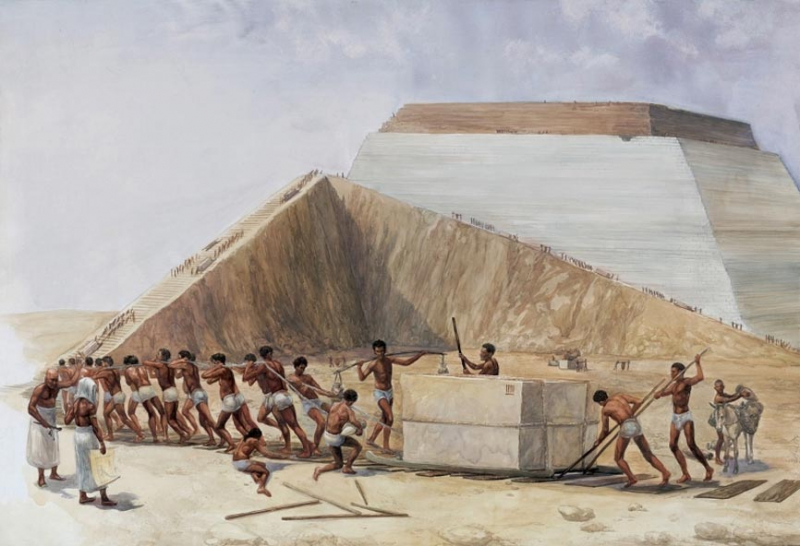Pyramids
On the list of Egyptian inventions, the ancient pyramids are unquestionably at the top. They are solid geometrical formations with a square foundation and four equal triangle sides, making them some of the most amazing constructions in the entire world. Ancient conquerors and travelers were enthralled by the Egyptian pyramids, and today's tourists, mathematicians, and archeologists who visit to investigate, measure, and describe them are still in awe of them.
Early Egyptian rulers' tombs were bench-shaped mounds known as mastabas. Imhotep, King Djoser's architect, built the first pyramid around 2780 BCE by stacking six mastabas, each smaller than the one underneath, to make a pyramid rising in steps. This Step Pyramid is located near Memphis on the west bank of the Nile River in Sakkara. It, like later pyramids, has different rooms and tunnels, including the king's burial chamber.
During the reign of King Snefru, the founder of the Fourth Dynasty, the transformation from the Step Pyramid to a real, smooth-sided pyramid occurred (2680–2560 BCE). A step pyramid was created at Medum, which was then filled in with stone and capped with a limestone casing. Construction on a pyramid with smooth sides began nearby at Bahshur. However, around halfway up, the angle of the incline reduces from about 51 degrees to around 43 degrees, and the sides climb less sharply, giving origin to the name "Bent Pyramid." The modification in angle was most likely made during construction to increase the building's stability. A real, but squat-appearing pyramid was created at Dahshur by building a second great pyramid there with its sides rising at an inclination of slightly more than 43 degrees.
The Great Pyramid of Giza, the largest and most famous of all the pyramids, was erected by Snefru's son - Khufu, also known as Cheops, the later Greek variant of his name. The base of the pyramid stretched over 13 acres, while its sides rose at an angle of 51 degrees 52 minutes and were over 755 feet long. It was previously over 481 feet tall; it is now 450 feet tall. Scientists believe that its stone blocks weigh more than two tons on average, with the largest weighing up to fifteen tons. At Giza, two other large pyramids were constructed for Khafre (Chephren) - King Khafu's son, and Menkaure (Mycerinus) - Khafre's successor. The renowned Sphinx, a huge statue of a lion with a human head created during Khafre's reign, is also found at Giza.
Pyramids were not standalone structures; they were a part of a complex that included contained temples, chapels, additional tombs, and substantial walls. Funerary boat remains have also been discovered, with Giza having the highest preservation. The Pyramid Texts, a significant repository of knowledge about Egyptian religion, are inscriptions found on the walls of the Fifth and Sixth Dynasty pyramids. However, it is challenging to be certain of the specific burial practices or the uses of all the structures in the pyramid complex due to the dearth of historical records. The king's body is believed to have been transported by boat up the Nile to the location of the pyramid, where it was likely mummified at the Valley Temple before being interred.
Pyramid construction has given rise to rumors. The rather soft stone may have been cut using the copper chisels, drills, and saws that the Egyptians had at their disposal. A more challenging issue would have arisen from the use of hard granite for the walls of the burial chambers and some of the outer casing. With the drills and saws, workers may have employed an abrasive powder, such as sand. The orientation of the pyramids to the cardinal points required astronomical knowledge, and the perimeter was likely leveled with water-filled trenches. Large stone slabs were dragged on sleds over the ground that was first made slick by liquid, as depicted in a tomb picture of a gigantic statue being lifted. The blocks were then transported to their placements inside the pyramid by way of ramps. Finally, the outer layer of casing stones was built from the top down, and the ramps were demolished as the construction was completed.
The majority of the stone for the Giza pyramids came from the Giza plateau itself. Some of the limestone casing was carried from Tura, across the Nile, while granite from Aswan was used in a few of the rooms. Quarry workers' marks, such as "craftsman-gang," may be found on some of the stone blocks, along with the names of the work gangs. Part-time labor teams most likely complemented the year-round masons and other skilled workers. In the fifth century BCE, the Greek historian Heroditus wrote that his Egyptian guides told him that 100,000 men were employed three months a year for twenty years to build the Great Pyramid; contemporary estimates of the number of employees are substantially lower.
The Fourth through Sixth Dynasties saw the peak of pyramid construction. Long after the first millennium, smaller pyramids were still being constructed. Many of them have been found, but many more likely still have their bodies buried beneath the sand. Later rulers were interred in secret tombs carved into rock cliffs as it became obvious that the pyramids did not offer protection for the mummified bodies of the kings but rather were obvious targets for grave robbers. Although the Egyptian rulers who built the majestic pyramids did not have their bodies protected by them, the pyramids have succeeded in perpetuating their names and histories.
















